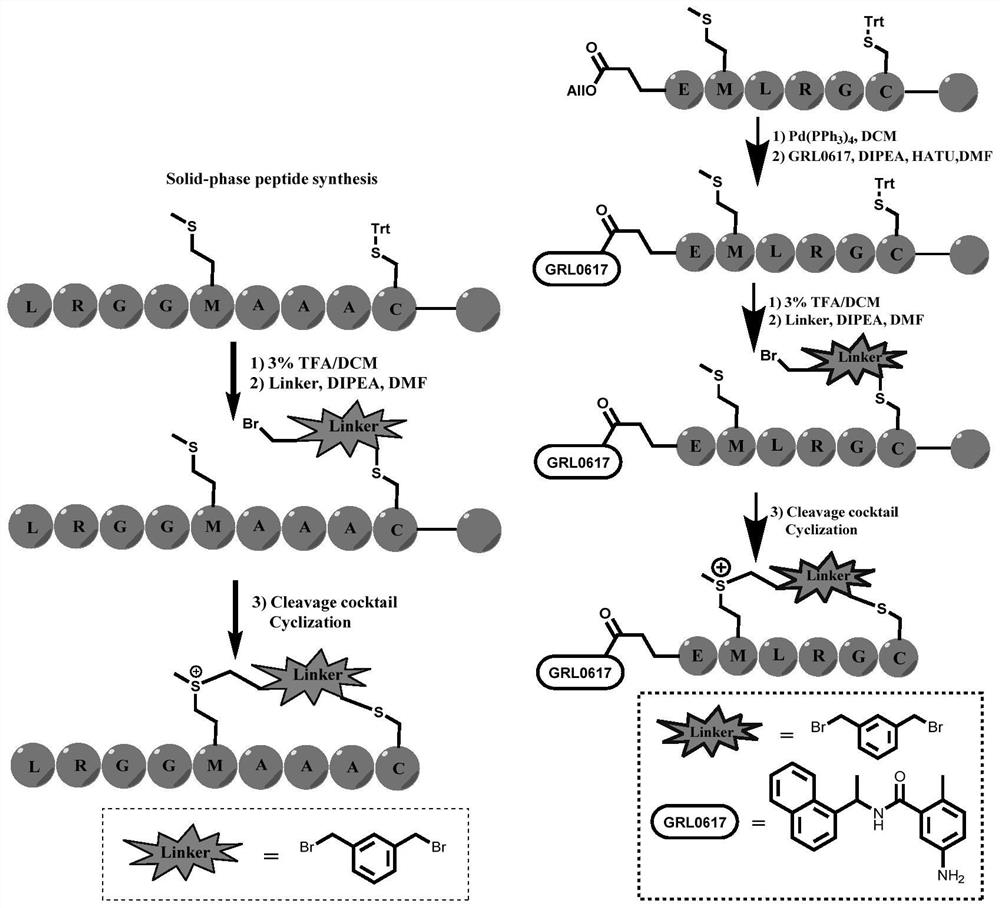Stable polypeptide protein covalent inhibitor of papain-like protease PLpro targeting 2019 novel coronavirus
A papain, coronavirus technology, applied in the field of bioengineering, can solve problems such as poor pneumonia
- Summary
- Abstract
- Description
- Claims
- Application Information
AI Technical Summary
Problems solved by technology
Method used
Image
Examples
Embodiment 1
[0028] The present invention adopts the sulfonium salt stabilized polypeptide technology reported in the previous literature (D.Wang, M.Yu, et al.Chem.Sci.10, 4966-4972), through the combination of methionine, cysteine and dialkylene on the polypeptide The sulfonium salt cyclic peptide can be reacted with a base-based reagent, which can not only stabilize the polypeptide, but also covalently modify the cysteine on the interaction site of the target protein, and block the papain-like protease PLpro and various non-structural proteins of the virus. Binding, inhibiting the replication of viral genes.
[0029] The present invention provides a series of stable polypeptide protein covalent inhibitors targeting 2019 novel coronavirus (SARS-CoV-2) papain-like protease (Papain-like protease, PLpro). The inventors synthesized a number of different polypeptides, as shown in Table 1.
[0030] Table 1: Molecular sequences of different stable polypeptide covalent inhibitors targeting t...
Embodiment 2
[0032] Preparation and separation and purification steps of the polypeptide of embodiment 2:
[0033] The polypeptide of the present invention is synthesized in solid phase according to the amino acid sequence, which is a conventional technique and will not be repeated here. This example only describes the core steps for preparing the above-mentioned stable polypeptide as follows (taking CM1 as an example):
[0034] Specific operation steps ( figure 1 )for:
[0035](1) Polypeptide solid-phase synthesis: Weigh Rink amide MBHA resin into a peptide tube, add dichloromethane (DCM), and swell with nitrogen gas for 30 minutes. Add 50% (v / v) morpholine in N,N-dimethylformamide (DMF) solution, blow nitrogen gas for 30 minutes, and remove the Fmoc protecting group. After washing the resin alternately with DMF and DCM, the prepared Fmoc-AA-OH (5eq, 0.4M, DMF) solution, 6-chlorobenzotriazole-1,1,3,3-tetramethylurea Fluorophosphate ester (HCTU) (5eq, 0.38M, DMF) solution and N,N-diiso...
Embodiment 3
[0038] Example 3 Polypeptide Molecule and Protein PLpro Covalent in Vitro
[0039] The methionine and cysteine on different polypeptides with fluorescent groups react with dialkylating reagents to form sulfonium salt cyclic peptides and respectively co-incubate with the protein, the protein and the sulfonium salt polypeptide undergo a covalent reaction, and the protein can be seen Fluorescent display on the strip ( figure 2 ), indicating that CM1-8 polypeptide can covalently react with PLpro protein, while general linear peptides cannot produce covalent linkage.
[0040] We choose the peptide EM-C as an example to study reaction kinetics and stoichiometry studies. FAM-labeled peptide EM-C (10 μM) was reacted with SARS-CoV-2 PLpro (5 μM) in PBS buffer for different times (0.5, 1, 2, 3, 4 hours). The response was dose-dependent. Kinetic and stoichiometric studies clearly show the high efficiency of binding ( image 3 A, B).
[0041] The polypeptide has good specificity, ...
PUM
 Login to View More
Login to View More Abstract
Description
Claims
Application Information
 Login to View More
Login to View More - R&D
- Intellectual Property
- Life Sciences
- Materials
- Tech Scout
- Unparalleled Data Quality
- Higher Quality Content
- 60% Fewer Hallucinations
Browse by: Latest US Patents, China's latest patents, Technical Efficacy Thesaurus, Application Domain, Technology Topic, Popular Technical Reports.
© 2025 PatSnap. All rights reserved.Legal|Privacy policy|Modern Slavery Act Transparency Statement|Sitemap|About US| Contact US: help@patsnap.com



